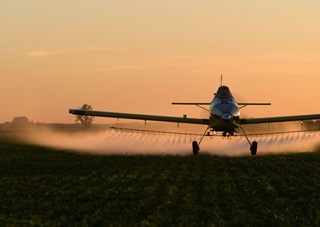
At low altitudes, drones can be even harder to spot than thought.
Visibility tests conducted by Think Before You Launch, a consortium of unmanned and manned aviation stakeholders dedicated to operator education, planned and organized the visibility tests during the Colorado Agricultural Aviation Association’s Operation S.A.F.E. events Oct. 1 and 2 in La Junta, Colorado. CAAA Executive Director Jessica Freeman said the visibility tests were one of three main elements of the two-day event, and found that pilots spraying crops have great difficulty spotting drones.
“Preliminary results show that in flight visual acquisition of a drone also in flight over agricultural land is much more difficult than originally anticipated,” Freeman wrote in an email. “However using ground tarps to make the work site more visible has real potential to warn a pilot in flight of UAS activity ahead. The visibility test data affirms that the manned and unmanned industries need to be very well educated about all types of flights that take place in the 0-400 foot airspace, and the low altitude users need to push for communication solutions, better UAV visibility measures, and technology like sense and avoid systems.”
A communications solution was also put through its paces during the event, with AirMap CEO Ben Marcus collaborating with UAS Colorado and agricultural pilots to test the software the company announced in June that runs on mobile devices and alerts drone operators about potential conflicts. Marcus reported in a blog post that drone and agricultural aircraft pilots were able to share information about planned operations.
While visibility test results were still preliminary, Freeman said it is very clear that coordination is essential.
“Right now a manned and unmanned aircraft should not be working in the same area of the airspace at the same time which will require clear communication to safely coordinate flight areas and times,” Freeman wrote.
Freeman said the Think Before You Launch campaign is focused on filling a gap left in current education programs such as the Know Before You Fly campaign backed by the FAA, industry, and other associations.
More than 15 manned flight industries across the nation already share the airspace up to 400 feet allotted to model aircraft and drones, Freeman noted, and “there is limited educational material available and the issue has not been discussed” by the Know Before You Fly safety campaign.
“Unfortunately an uneducated legal UAS operator could follow all of the FAA recommendations and still potentially cause a fatal mid-air collision, leaving the operator in jeopardy of unknown civil liabilities. This is a safety issue for both the pilots of the manned aircraft working at low altitudes as well as the UAS operators,” Freeman said.
The Operation S.A.F.E. event also included spray testing that gives operators a chance to calibrate and adjust systems to ensure precision, and free training for EMS personnel and first responders on how to help pilots involved in accidents. Responders were given training customized for a variety of agricultural aircraft types. The CAAA has made a training manual available online.



